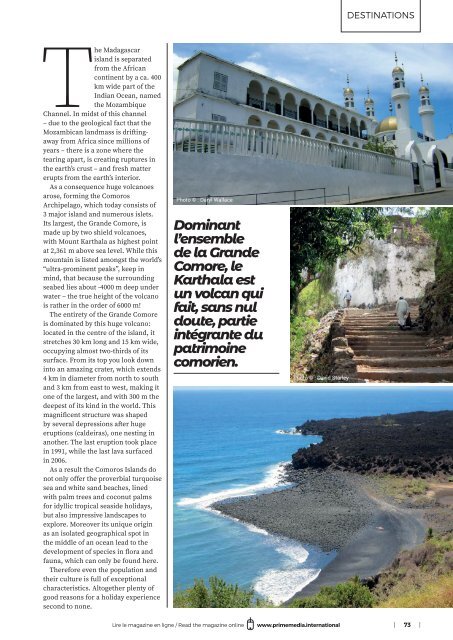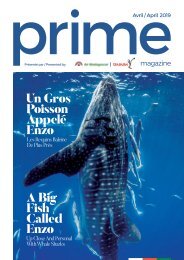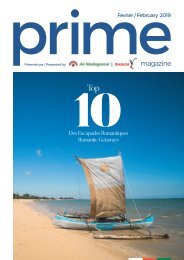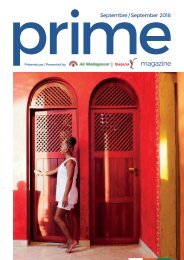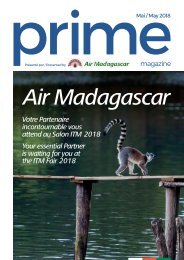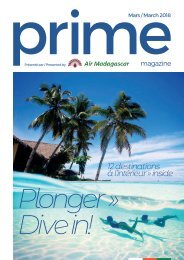PRIME MAG - AIR MAD - JUNE 2018 - SINGLE PAGES LO-RES
You also want an ePaper? Increase the reach of your titles
YUMPU automatically turns print PDFs into web optimized ePapers that Google loves.
DESTINATIONS<br />
The Madagascar<br />
island is separated<br />
from the African<br />
continent by a ca. 400<br />
km wide part of the<br />
Indian Ocean, named<br />
the Mozambique<br />
Channel. In midst of this channel<br />
– due to the geological fact that the<br />
Mozambican landmass is driftingaway<br />
from Africa since millions of<br />
years – there is a zone where the<br />
tearing apart, is creating ruptures in<br />
the earth’s crust – and fresh matter<br />
erupts from the earth’s interior.<br />
As a consequence huge volcanoes<br />
arose, forming the Comoros<br />
Archipelago, which today consists of<br />
3 major island and numerous islets.<br />
Its largest, the Grande Comore, is<br />
made up by two shield volcanoes,<br />
with Mount Karthala as highest point<br />
at 2,361 m above sea level. While this<br />
mountain is listed amongst the world’s<br />
“ultra-prominent peaks”, keep in<br />
mind, that because the surrounding<br />
seabed lies about -4000 m deep under<br />
water – the true height of the volcano<br />
is rather in the order of 6000 m!<br />
The entirety of the Grande Comore<br />
is dominated by this huge volcano:<br />
located in the centre of the island, it<br />
stretches 30 km long and 15 km wide,<br />
occupying almost two-thirds of its<br />
surface. From its top you look down<br />
into an amazing crater, which extends<br />
4 km in diameter from north to south<br />
and 3 km from east to west, making it<br />
one of the largest, and with 300 m the<br />
deepest of its kind in the world. This<br />
magnificent structure was shaped<br />
by several depressions after huge<br />
eruptions (caldeiras), one nesting in<br />
another. The last eruption took place<br />
in 1991, while the last lava surfaced<br />
in 2006.<br />
As a result the Comoros Islands do<br />
not only offer the proverbial turquoise<br />
sea and white sand beaches, lined<br />
with palm trees and coconut palms<br />
for idyllic tropical seaside holidays,<br />
but also impressive landscapes to<br />
explore. Moreover its unique origin<br />
as an isolated geographical spot in<br />
the middle of an ocean lead to the<br />
development of species in flora and<br />
fauna, which can only be found here.<br />
Therefore even the population and<br />
their culture is full of exceptional<br />
characteristics. Altogether plenty of<br />
good reasons for a holiday experience<br />
second to none.<br />
Photo © : Daryl Wallace<br />
Dominant<br />
l’ensemble<br />
de la Grande<br />
Comore, le<br />
Karthala est<br />
un volcan qui<br />
fait, sans nul<br />
doute, partie<br />
intégrante du<br />
patrimoine<br />
comorien.<br />
Photo © : David Starley<br />
The entirety<br />
of the Grande<br />
Comore is<br />
dominated<br />
by this huge<br />
volcano:<br />
located in the<br />
centre of the<br />
island.<br />
Lire le magazine en ligne / Read the magazine online<br />
www.primemedia.international<br />
| 73 |


